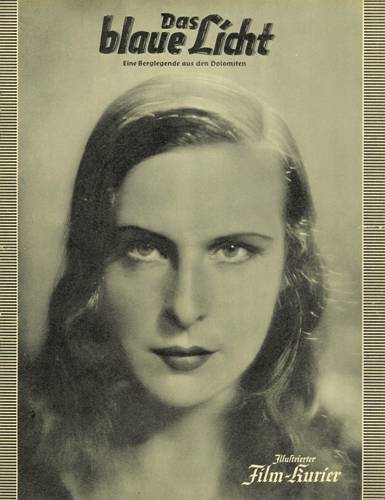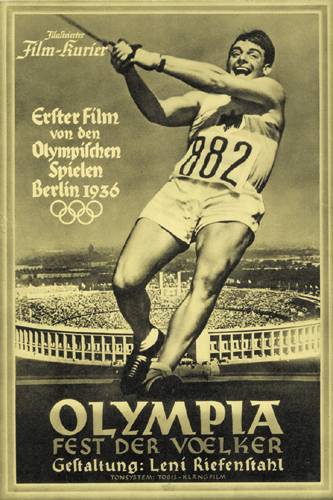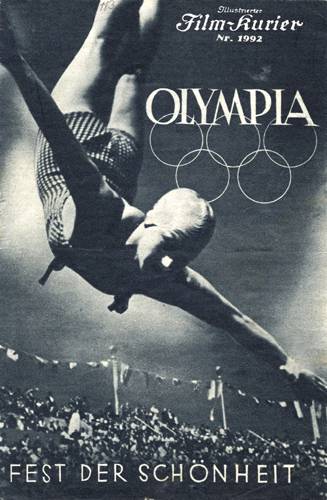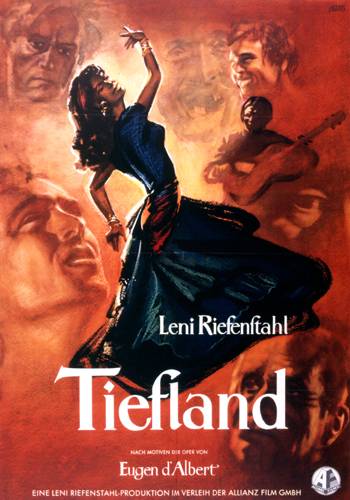El 9 de Noviembre ha fallecido, a los 101 años de edad , la controvertida realizadora alemana Leni Riefenstahl, artista polifacética, pionera y una mujer de armas tomar; vitalista, intuitiva, emprendedora, atrevida, inteligente, magnética y creativa como pocas.
Directora, actriz, bailarina, guionista, montadora, fotógrafa, productora, intrépida deportista, y vete tú a saber qué más, Leni fue íntima amiga de los más destacados líderes del régimen nazi (entre ellos el propio Hitler y Goebbles) y fue considerada la cineasta oficial del Tercer Reich por sus cintas de propaganda "El Triunfo de la Voluntad" (1934) y la hermosísima "Olimpia" (1938), de más que recomendable visionado, como su completa filmografía.
Seguramente estas simpatías le costaron otras tantas antipatías terminado el dominio hitleriano y su nombre no es que haya trascendido sin pena ni gloria a los anales de la historia del cine, pero sí lo ha hecho con injustas letras minúsculas, a pesar de los premios recibidos y de sus grandes aportaciones a la técnica cinematográfica. Porque obviando -que no disculpando- los servicios profesionales (o no) prestados a Hitler y sus ideas políticas, el trabajo que realizó Riefenstahl es poco menos que digno de admiración. La germana disponía de un inusitado talento detrás de las cámaras -por no mencionar el turbio hipnotismo que provocaba ante éstas-. Su concepción estética, su impresionante sentido de lo visual, del ritmo y de la luz, de la belleza de los cuerpos como arquitecturas y de los espacios, la condujeron a componer gloriosas escenas de aborrecible contenido ideológico (propaganda nazi era al fin y al cabo) pero embelesadoras como experiencia para los sentidos.
En los últimos años de su vida, Leni practicó el submarinismo, medio que utilizó para seguir filmando sus películas subacuáticas. También se recluyó en Nuba (África), en cuyas gentes y paisajes centró la atención de su objetivo fotográfico.
Al parecer, la galardonada actriz y directora Jodie Foster tenía intención de llevar a la pantalla grande un proyecto que tradujese en imágenes la vida de esta fascinante realizadora alemana.

Filmografia como directora:
1932 - DAS BLAUE LICHT Eine Legende aus dem Sarntal

Production:L.R.(=Leni Riefenstahl) - Studio-Film of Sokal-Film GmbH Production management:Walter Traut
Script:Béla Balázs, Leni Riefenstahl
Direction:Leni Riefenstahl cooperation with Béla Balézs (not named in the trailer)
Camera:Hans Schneeberger
Music:Giuseppe Becce
Actors:Leni Riefenstahl, Mathias Wieman, Max Holzboer, Beni Führer,
Martha Mair, Franz Maldacea and farmer from the Sarn valley
Length:2,344 m
First performance:24 March 1932
»Dr. Fanck has always made nice pictures giving the impression of a
fairy tale through the backlit, the snow, the ice and the glittering and the blossoms etc., but the plot had been realistic. In addition, I felt that realistic plots required realistic pictures too. This means, that if you want to show beautiful pictures, which I liked, then you should present a plot too coming out of either a fairy-tale world or a legend or a ballad where the nice subject is a requirement. While in a usual happening where somebody rescues someone or if you are flying, I mean something realistic is happening, the sun could shine but the weather could be bad too as it might be in real life. And this feeling, that it would be good if form and content coincide, out of this wish I developed the thought that in order to be able to present such pictures I should write a ballad, a fairy tale or a legend. That was the basic idea. And that is why I wrote »Das Blaue Licht« for this legend is almost challenging to produce it in off-beat pictures.«
1933 - SIEG DES GLAUBENS
Production: Propagandaministerium, Hauptabteilung Film
Direction: Leni Riefenstahl
Production management: Arnold Raether
Technical management: R. Quaas
Camera: Sepp Allgeier, Franz Weimayr, Walter Frentz, R. Quaas, P. Tesch
Music: Herbert Windt
Length: circa 1,700 m
First performance: 01 December 1933
Documentary film about the NSDAP's 5th Reich Party Congress, which was held in Nuremberg from August 30th until September 3rd 1933.
The Propaganda Ministry through the central film hire services had lent the film. Since the end of the war, it had been impossible to get hold of a copy of it. Yet, there might be one in the archives of the former GDR or the former Soviet Union.
1935 - TRIUMPH DES WILLENS

Production: Reichsparteitagsfilm from L.R. Studio-Film
Production management: Walter Traut
Director: Leni Riefenstahl
Photographic management: Sepp Allgeier
Camera: Sepp Allgeier, Karl Altenberger, Werner Buhne, Walter Frentz, Hans Gottschalk, Werner Hundhausen, Herbert Kebelmann, Albert Kling, Franz Koch, Herbert Kutschbach, Paul Lieberenz, Richard Nickel, Walter Riml, Arthur v. Schwertfeger, Karl Vass, Franz Weimayr, Siegfried Weinmann, Karl Wellet
Special shots: Sven Noldan, Fritz Brutsch, Hans Noack
Assistants: Erna Peters, Guzzi und Otto Lantschner, Walter Prager, Wolfgang Brüning
Length: 3,109 m
First performance: 28 March 1935
"El triunfo de la voluntad" (Triumph des Willens, 1934) arranca de una inocente y tímida coartada argumental (el congreso nazi celebrado ese año en Nüremberg) para glorificar el proyecto político de Hitler, presentado al principio de la película como un Dios que cae del cielo (la secuencia de la llegada en avión). Como todo Dios, es aclamado y vitoreado por el pueblo enferyorecido, por lo que son recurrentes e inevitables los planos del público, tanto civil como militar. El documental consiste, básicamente, en mostrar toda la maquinaria de desfiles nazis y en ver lo amaestrado y embobado que estaba un pueblo que soportaba sin inmutarse (e incluso con pasión) los discursos continuados de toda la cúpula dirigente del partido único, concluyendo con el maestro de ceremonias, Adolf Hitler"
1935 - TAG DER FREIHEIT - UNSERE WEHRMACHT
Production: Reichsparteitagsfilm from L.R. Studio-Film
Direction: Leni Riefenstahl
Camera: Willi Zielke, Guzzi Lantschner and 3 more
Length: circa 800 m
First performance: December 1935
Documentary film about the Wehrmacht's manoeuvre during the NSDAP's 7th Reich Party Congress which was held in Nuremberg from September 10th till September 16th 1935.
The film had been shown in the UFA's preceding program.
1938 - OLYMPIA
Part 1: FEST DER VÖLKER
Part 2: FEST DER SCHÖNHEIT


Production: Olympia-Film GmbH
Production management: Walter Traut
Director: Leni Riefenstahl
Camera: Hans Ertl, Walter Frentz, Guzzi Lantschner, Kurt Neubert, Hans Scheib, Willi Zielke, Andor von Barsy, Wilfr. Basse, Jos. Dietze, E. Epkens, F. von Friedl, Hans Gottschalk, Richard Groschapp, W. Hameister, Wolf Hart, Hasso Hartnagel, Walter Hege, E. von der Heyden, Albert Höcht, Paul Holzki, W. Hundhausen, H. von Jaworki, H. v. Kaweczynski, H. Kebelmann, S. Ketterer, Albert Kling, Ernst Kunstmann, Leo de Laforgue, Lagorio, E. Lambertini, Otto Lantschner, Waldemar Lemke, Georg Lemki, C. A. Linke, E. Nitzschemann, Albert Schattmann, Wilhelm Schmidt, Hugo Schulze, L. Schwedler, Alfred Siegert, W. Siehm, Ernst Sorge, H. von Stwolinski, Karl Vass
Music: Herbert Winde, Walter Gronostay
Speaker of the German version: Paul Laven, Rolf Wernicke
Length: Part 1: 3,269 m
Part 2: 2,712 m
First performance: 20 April 1938
The six chief cameramen have been especially dealing with the following shots: Ertl - underwater pictures, running competitions
Frentz - sailing regatta, marathon course (hand camera), captive balloon pictures
Lantschner - hand camera: training, travelling, gymnastics, swimming, rowing
Neubert - slow motion pictures
Scheib - mainly telephoto pictures
Zielke - prologue
"Olimpiada" (Olympia, 1938), un documental sobre los Juegos Olímpicos celebrados en Berlín en 1936. Si hoy en día la retransmisión de estos eventos están protagonizados por personas como Olga Viza o Matías Prats envueltos por un ejército de técnicos funcionarios preocupados por enfocar a la familia Real aplaudiendo los goles de uno de sus miembros, los Juegos de Berlín contaron con una funcionaria de mayor carácter: Leni Riefenstahl, que ideó un montón de artificios para conseguir planos inverosímiles de los atletas arios batiendo nuevas marcas sin despeinarse.
1952 - DAS BLAUE LlCHT
The new cut and sound version of the film from 1932 had been produced in Rome in 1951. Length: 1,967 m.
1954 - TIEFLAND

Production: Riefenstahl-Film GmbH
Script: Leni Riefenstahl, Harald Reinl after an opera by Eugen d'Albere
Director: Leni Riefenstahl, (not named in the trailer:) G. W. Pabst
Camera: Albert Benitz
Music: Herbert Winde
Sets: Isabella Ploberger
Actors: Leni Riefenstahl, Franz Eichberger, Bernhard Minetti, Aribert Wäscher, Maria Koppenhöfer, Luis Rainer, Frieda Richard, Karl Skramps, Max Holzboer
Length: 2,695 m
First performance: 11 February 1954
The shots for Tiefland were made with long breaks from 1940 until the end of the war. In 1953, the French confiscated the material. The sound recording and the film editing could take place first after that.

